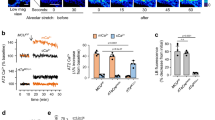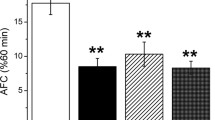Abstract
Pulmonary exposure to oleic acid (OA) is associated with permeability alterations and cellular damage; however, the exact relationship between these two effects has not been clearly established. Using cultured alveolar epithelial monolayers, we demonstrated that OA and some other fatty acids (≤50 µM) can induce permeability changes without detectable cellular damage. At higher concentrations, however, OA caused severe membrane damage and leakage to solute flux. The permeability enhancing effect of OA was observed with both the paracellular marker 3H-mannitol and the lipophilic transcellular indicator 14C-progesterone. While the effect of OA on transcellular permeability may be attributed to its known effect on membrane fluidity, the paracellular promoting effect of OA and its mechanism are not well established. We postulated that OA may increase paracellular permeability through a Ca2+-dependent tight junction mechanism. Using dual-excitation fluorescence microscopy, we demonstrated that OA can increase intracellular calcium, [Ca2+]i , in a dose-dependent manner. This effect was transient at low OA concentrations (≤50 µM) but became more pronounced and sustained at higher concentrations. Free hydroxyl and unsaturated groups were required for this activation since esterified OA (oleic methyl ester) and stearic acid (a saturated fatty acid with equal chain length) had much reduced effects on both the [Ca2+]i and the permeability alterations. Degree of unsaturation was unimportant since linolenic acid (18:3), linoleic acid (18:2), and OA (18:1) had similar and comparable effects on the two parameters. When the alveolar epithelium was bathed with Ca2+ -free medium, OA failed to elevate [Ca2+ ]i , suggesting that Ca2+ influx from the extracellular medium is responsible for the observed [Ca2+]i rise. This effect of OA was not due to nonspecific membrane damage since the monolayer maintained its integrity and the [Ca2+]ireturned to pretreatment levels after an initial transient rise. Moreover, the permeability alteration was fully reversible upon removal of OA. These results suggest that the alveolar permeability may be reversibly enhanced by sublethal concentrations of oleic acid.
Similar content being viewed by others
REFERENCES
C. L. Gay, T. M. Murphy, J. Hadgraft, I. W. Kellaway, J. C. Evans, and C. C. Rowlands. An electron spin resonance study of skin penetration enhancers. Int. J. Pharm. 49:39 (1989).
N. Muranushi, N. Takagi, S. Muranishi, and H. Sezaki. Effects of fatty acids and monoglycerides on permeability of lipid bilayer. Chem. Phys. Lipids 28:269 (1981).
K. D. Lillemoe, T. R. Gadacz, R. H. Weichbrod, and J. W. Harmon. Effects of mono-octanoin on canine gastric mucosa. Surg. Gynecol. Obstet. 155:13 (1982).
K. Sato, K. Sugibayashi, and Y. Morimoto. Effect and mode of action of aliphatic esters on the in vitro skin permeation of nicorandil. Int. J. Pharm. 43:31 (1988).
B. J. Aungst. Structure/effect studies of fatty acid isomers as skin penetration enhancers and skin irritants. Pharm. Res. 6:244 (1989).
B. T. Peterson, K. D. Dickerson, H. L. James, E. J. Miller, J. W. McLarty, and D. B. Holiday. Comparison of three tracers for detecting lung epithelial injury in anesthetized sheep. J. Appl Physiol. 66:2374 (1989).
R. W. Niven and P. R. Byron. Solute absorption from the airways of the isolated rat lung. II. Effect of surfactants on absorption of fluorescein. Pharm. Res. 7:8 (1990).
J. M. Haung, H. Xian, and M. Bacaner. Long-chain fatty acids activate calcium channels in ventricular myocytes. Proc. Natl. Acad. Sci. USA 89:6452 (1992).
M. J. Diaz-Guerra, M. Junco, and L. Bosca. Oleic acid promotes changes in the subcellular distribution of protein kinase C in isolated hepatocytes. J. Biol. Chem. 266:23568 (1991).
D. L. Barber, A. M. Cacace, D. T. Raucci, and M. B. Ganz. Fatty acids stereospecifically stimulate neurotension release and increase [Ca2+]i in enteric endocrine cells. Am. J. Physiol. 261:G497 (1991).
M. J. Rutten, N. Cogburn, C. S. Schasteen, and T. Solomon. Physiological and cytotoxic effects of Ca2+ ionophores on Caco-2 paracellular permeability: Relationship of 45Ca2+ efflux to 51Cr release. Pharmacology 42:158 (1991).
A. Martinez-Palomo, I. Meza, G. Beaty, and M. Cereijido. Experimental modulation of occluding junctions in a cultured transporting epithelium. J. Cell Biol. 87:736 (1980).
M. Bhat, L. Y. Wang, C. J. Malanga, D. Toledo-Velasquez, J. K. H. Ma, and Y. Rojanasakul. Regulation of tight junction permeability by calcium mediators and cell cytoskeleton in rabbit tracheal epithelium. Pharm. Res. 10:991–997 (1993).
L. Y. Wang, D. Toledo-Velasquez, D. Schwegler-Berry, J. K. H. Ma, and Y. Rojanasakul. Transport and hydrolysis of enkephalins in cultured alveolar epithelial monolayers. Pharm. Res. 10:1662–1667 (1993).
K. L. Rice, P. G. Duane, G. Mielke, A. A. Sinha, and D. E. Niewoehner. Calcium ionophores injure alveolar epithelial cells: Relation to phospholipase activity. Am. J. Physiol. 259:L439 (1990).
M. Murakami, K. Takada, and S. Muranishi. Further mechanistic study on intestinal absorption enhanced by unsaturated fatty acids: Reversible effect by sulfhydryl modification. Biochim. Biophys. Acta. 1117:83 (1992).
Author information
Authors and Affiliations
Rights and permissions
About this article
Cite this article
Wang, L.Y., Ma, J.K.H., Pan, W.F. et al. Alveolar Permeability Enhancement by Oleic Acid and Related Fatty Acids: Evidence for a Calcium-Dependent Mechanism. Pharm Res 11, 513–517 (1994). https://doi.org/10.1023/A:1018906330308
Issue Date:
DOI: https://doi.org/10.1023/A:1018906330308




